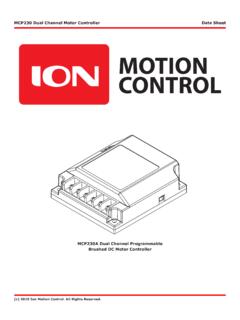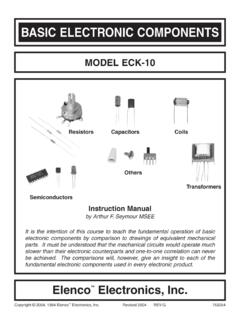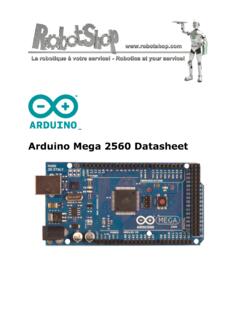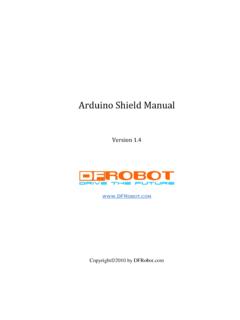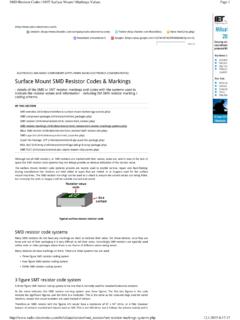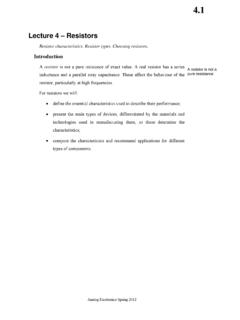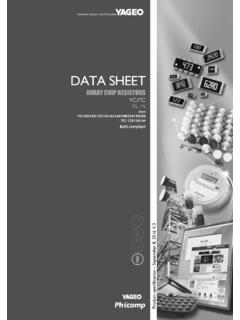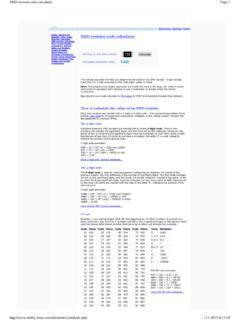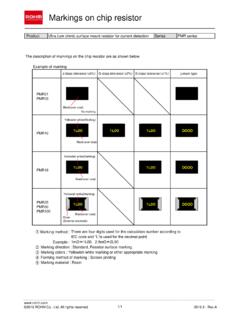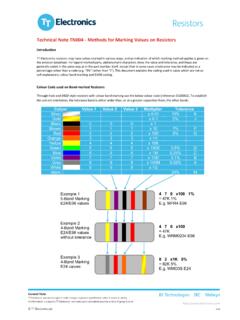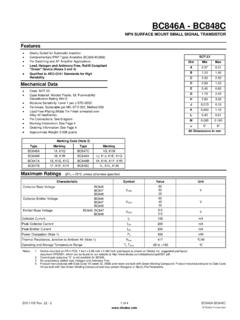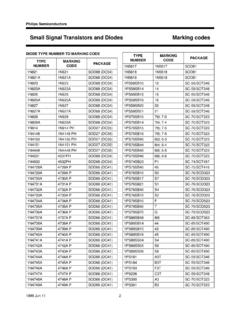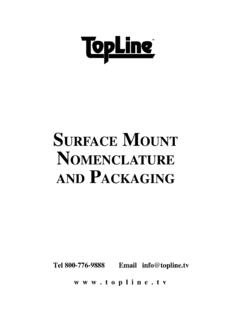Transcription of Resistors - robotshop.com
1 1/20/2018 Resistors - SHOP LEARN BLOG SUPPORTCONTRIBUTORS: JIMB0 FAVORITE25 Take a Stance, The Resist StanceResistors - the most ubiquitous of electronic components. They are a critical piece in just about every circuit. And they play a major role in our favorite equation, Ohm s this, our pi ce de r sistance, we ll cover:What is a resistor ?! resistor unitsResistor circuit symbol(s) Resistors in series and parallelDifferent variations of resistorsColor coding decodingSurface mount resistor decodingExample resistor applicationsConsider of the concepts in this tutorial build on previous electronics knowledge. Before jumping into this tutorial, consider reading (at least skimming) these first:What is Electricity?Voltage, Current, Resistance, and Ohm s LawWhat is a CircuitSeries vs. Parallel CircuitsHow to Use A Multimeter - Specifically check out the measuring resistance PrefixesResistor BasicsResistors are electronic components which have a specific, never-changing electrical resistance.
2 The resistor s resistance limits the flow of electrons through a are passive components, meaning they only consume power (and can t generate it). Resistors are usually added to circuits where they complement active componentslike op-amps, microcontrollers, and other integrated circuits. Commonly Resistors are used to limit current, divide voltages, and pull-up I/O unitsThe electrical resistance of a resistor is measured in ohms. The symbol for an ohm is the greek capital-omega: . The (somewhat roundabout) definition of 1 is theresistance between two points where 1 volt (1V) of applied potential energy will push 1 ampere (1A) of SI units go, larger or smaller values of ohms can be matched with a prefix like kilo-, mega-, or giga-, to make large values easier to read. It s very common to see resistorsin the kilohm (k ) and megaohm (M ) range (much less common to see miliohm (m ) Resistors ). For example, a 4,700 resistor is equivalent to a resistor , and a5,600,000 resistor can be written as 5,600k or (more commonly as).
3 Schematic symbolAll Resistors have two terminals, one connection on each end of the resistor . When modeled on a schematic, a resistor will show up as one of these two symbols:Two common resistor schematic symbols. R1 is an American-style 1k resistor , and R2 is an international-style 47k terminals of the resistor are each of the lines extending from the squiggle (or rectangle). Those are what connect to the rest of the circuit. 1/20/2018 Resistors - resistor circuit symbols are usually enhanced with both a resistance value and a name. The value, displayed in ohms, is obviously critical for both evaluating and actuallyconstructing the circuit. The name of the resistor is usually an R preceding a number. Each resistor in a circuit should have a unique name/number. For example, here s a fewresistors in action on a 555 timer circuit:In this circuit, Resistors play a key role in setting the frequency of the 555 timer s output.
4 Another resistor (R3) limits the current through an of ResistorsResistors come in a variety of shapes and sizes. They might be through-hole or surface- mount . They might be a standard, static resistor , a pack of Resistors , or a specialvariable and mountingResistors will come in one of two termination-types: through-hole or surface- mount . These types of Resistors are usually abbreviated as either PTH (plated through-hole) orSMD/SMT (surface- mount technology or device).Through-hole Resistors come with long, pliable leads which can be stuck into a breadboard or hand-soldered into a prototyping board or printed circuit board (PCB). Theseresistors are usually more useful in breadboarding, prototyping, or in any case where you d rather not solder tiny, little SMD Resistors . The long leads usuallyrequire trimming, and these Resistors are bound to take up much more space than their surface- mount most common through-hole Resistors come in an axial package.
5 The size of an axial resistor is relative to its power rating. A common W resistor measures about , while a smaller W resistor is about half-watt ( W) resistor (above) sized up to a quarter-watt ( W).Surface- mount Resistors are usually tiny black rectangles, terminated on either side with even smaller, shiny, silver, conductive edges. These Resistors are intended to sit ontop of PCBs, where they re soldered onto mating landing pads. Because these Resistors are so small, they re usually set into place by a robot, and sent through an oven wheresolder melts and holds them in tiny 0603 330 resistor hovering over shiny George Washington s nose on top of a Resistors come in standardized sizes; usually either 0805 ( long by wide), 0603, or 0402. They re great for mass circuit-board-production, or in designswhere space is a precious commodity. They take a steady, precise hand to manually solder, though! resistor compositionResistors can be constructed out of a variety of materials.
6 Most common, modern Resistors are made out of either a carbon, metal, or metal-oxide film. In these Resistors , athin film of conductive (though still resistive) material is wrapped in a helix around and covered by an insulating material. Most of the standard, no-frills, through-hole resistorswill come in a carbon-film or metal-film - inside the guts of a few carbon-film Resistors . Resistance values from top to bottom: 27 , 330 and a . Inside the resistor , a carbon film is wrapped around aninsulator. More wraps means a higher resistance. Pretty neat!Other through-hole Resistors might be wirewound or made of super-thin metallic foil. These Resistors are usually more expensive, higher-end components specifically chosenfor their unique characteristics like a higher power-rating, or maximum temperature Resistors are usually either thick or thin-film variety. Thick-film is usually cheaper but less precise than thin. In both resistor types, a small film of resistivemetal alloy is sandwiched between a ceramic base and glass/epoxy coating, and then connected to the terminating conductive resistor packagesThere are a variety of other, special-purpose Resistors out there.
7 Resistors may come in pre-wired packs of five-or-so resistor arrays. Resistors in these arrays may share acommon pin, or be set up as voltage array of five 330 Resistors , all tied together at one don t have to be static either. Variable Resistors , known as rheostats, are Resistors which can be adjusted between a specific range of values. Similar to the rheostatis the potentiometer. Pots connect two Resistors internally, in series, and adjust a center tap between them creating an adjustable voltage divider. These variable Resistors areoften used for inputs, like volume knobs, which need to be smattering of potentiometers. From top-left, clockwise: a standard 10k trimpot, 2-axis joystick, softpot, slide pot, classic right-angle, and a breadboard friendly 10k resistor MarkingsThough they may not display their value outright, most Resistors are marked to show what their resistance is. PTH Resistors use a color-coding system (which really adds someflair to circuits), and SMD Resistors have their own value- marking the color bandsThrough-hole, axial Resistors usually use the color-band system to display their value.
8 Most of these Resistors will have four bands of color circling the first two bands indicate the two most-significant digits of the resistor s value. The third band is a weight value, which multiplies the two significant digits by a power final band indicates the tolerance of the resistor . The tolerance explains how much more or less the actual resistance of the resistor can be compared to what its nominalvalue is. No resistor is made to perfection, and different manufacturing processes will result in better or worse tolerances. For example, a 1k resistor with 5% tolerance couldactually be anywhere between and .How do you tell which band is first and last? The last, tolerance band is often clearly separated from the value bands, and usually it ll either be silver or s a table of each of the colors and which value, multiplier or tolerance they represent:1/20/2018 Resistors - valueMultiplierMultiplied OutToleranceBlack0101 Brown11010 Red210100 Orange3101,000 Yellow41010000 Green510100,000 Blue6101,000,000 Violet71010,000,000 Gray810100,000,000 White9101,000,000,000 Gold 5%Silver 10%Here s an example of a resistor with four color bands:When decoding the resistor color bands, consult a resistor color code table like the one above.
9 For the first two bands, find that color s corresponding digit value. The resistor has color bands of yellow and violet to begin - which have digit values of 4 and 7 (47). The third band of the is red, which indicates that the 47 should bemultiplied by 10 (or 100). 47 times 100 is 4,700!If you re trying to commit the color band code to memory, a mnemonic device might help. There are a handful of (sometimes unsavory) mnemonics out there, to helpremember the resistor color code. A good one, which spells out the difference between black and brown is:"Big brown rabbits often yield great big vocal groans when gingerly snapped."Or, if you remember ROY G. BIV , subtract the indigo (poor indigo, no one remembers indigo), and add black and brown to the front and gray and white to the back of theclassic rainbow Code CalculatorIf you d rather skip the math (we won t judge :), and just use a handy calculator, give this a try!Band 1 Band 2 Band 3 Band 4 Value 1 (MSV)Value 2 WeightToleranceBrown (1)Black (0)Red (100) Gold ( 5%)Resistance: 1,000 5%Decoding surface- mount markingsSMD Resistors , like those in 0603 or 0805 packages, have their own way of displaying their value.
10 There are a few common marking methods you ll see on these ll usually have three to four characters numbers or letters printed on top of the the three characters you re seeing are all numbers, you re probably looking at an E24 marked resistor . These markings actually share some similarity with the color-bandsystem used on the PTH Resistors . The first two numbers represent the first two most-significant digits of the value, the last number represents a the above example picture, Resistors are marked 104, 105, 205, 751, and 754. The resistor marked with 104 should be 100k (10x10), 105 would be 1M (10x10), and205 is 2M (20x10). 751 is 750 (75x10), and 754 is 750k (75x10).Another common coding system is E96, and it s the most cryptic of the bunch. E96 Resistors will be marked with three characters two numbers at the beginning and a letterat the end. The two numbers tell you the first three digits of the value, by corresponding to one of the not-so-obvious values on this lookup - letter at the end represents a multiplier, matching up to something on this or or H10E10000X or a 01C resistor is our good friend, 10k (100x100), 01B is 1k (100x10), and 01D is 100k.




